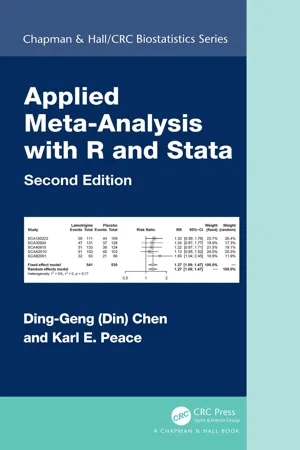
Applied Meta-Analysis with R and Stata
Ding-Geng (Din) Chen, Karl E. Peace
- 424 Seiten
- English
- ePUB (handyfreundlich)
- Über iOS und Android verfügbar
Applied Meta-Analysis with R and Stata
Ding-Geng (Din) Chen, Karl E. Peace
Über dieses Buch
Review of the First Edition:
The authors strive to reduce theory to a minimum, which makes it a self-learning text that is comprehensible for biologists, physicians, etc. who lack an advanced mathematics background. Unlike in many other textbooks, R is not introduced with meaningless toy examples; instead the reader is taken by the hand and shown around some analyses, graphics, and simulations directly relating to meta-analysis… A useful hands-on guide for practitioners who want to familiarize themselves with the fundamentals of meta-analysis and get started without having to plough through theorems and proofs.
— Journal of Applied Statistics
Statistical Meta-Analysis with R and Stata, Second Edition provides a thorough presentation of statistical meta-analyses (MA) with step-by-step implementations using R/Stata. The authors develop analysis step by step using appropriate R/Stata functions, which enables readers to gain an understanding of meta-analysis methods and R/Stata implementation so that they can use these two popular software packages to analyze their own meta-data. Each chapter gives examples of real studies compiled from the literature. After presenting the data and necessary background for understanding the applications, various methods for analyzing meta-data are introduced. The authors then develop analysis code using the appropriate R/Stata packages and functions.
What's New in the Second Edition:
-
- Adds Stata programs along with the R programs for meta-analysis
-
- Updates all the statistical meta-analyses with R/Stata programs
-
- Covers fixed-effects and random-effects MA, meta-regression, MA with rare-event, and MA-IPD vs MA-SS
-
- Adds five new chapters on multivariate MA, publication bias, missing data in MA, MA in evaluating diagnostic accuracy, and network MA
Suitable as a graduate-level text for a meta-data analysis course, the book is also a valuable reference for practitioners and biostatisticians (even those with little or no experience in using R or Stata) in public health, medical research, governmental agencies, and the pharmaceutical industry.
Häufig gestellte Fragen
Information
1
1.1 Introduction to R for Meta-Analysis
1.1.1 What is R?
1.1.2 Steps on Installing R and Updating R Packages
http://CRAN.r-project.org
1.1.2.1 First Step: Install R Base System
http://CRAN.r-project.org
http://CRAN.r-project.org/bin/windows/base/release.htm
Inhaltsverzeichnis
- Cover
- Half Title
- Series Page
- Title Page
- Copyright Page
- Dedication
- Table of Contents
- Preface for the Second Edition
- Preface for the First Edition
- Authors
- List of Figures
- List of Tables
- 1 Introduction to R and Stata for Meta-Analysis
- 2 Research Protocol for Meta-Analyses
- 3 Fixed Effects and Random Effects in Meta-Analysis
- 4 Meta-Analysis with Binary Data
- 5 Meta-Analysis for Continuous Data
- 6 Heterogeneity in Meta-Analysis
- 7 Meta-Regression
- 8 Multivariate Meta-Analysis
- 9 Publication Bias in Meta-Analysis
- 10 Strategies to Handle Missing Data in Meta-Analysis
- 11 Meta-Analysis for Evaluating Diagnostic Accuracy
- 12 Network Meta-Analysis
- 13 Meta-Analysis for Rare Events
- 14 Meta-Analyses with Individual Patient-Level Data versus Summary Statistics
- 15 Other R/Stata Packages for Meta-Analysis
- Bibliography
- Index